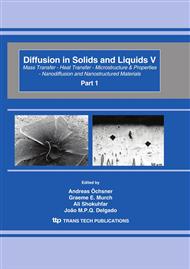p.308
p.318
p.330
p.339
p.344
p.351
p.359
p.365
p.370
The Effects of Homogenization Time and Cooling Environment on Microstructure and Transformation Temperatures of Ni-42.5wt%Ti-7.5wt%Cu Alloy
Abstract:
The present paper deals with different effects of homogenization time and cooling environment on Ni-42.5wt%Ti-7.5wt%Cu alloy. The alloy was prepared by vacuum arc melting. Afterwards, three homogenization times (half, one and two hour) and three cooling environments (water, air and furnace) at 1373 K were selected. Optical and Scanning Electron Microscopic methods, EDX, DSC and hardness tests have been used to evaluate the microstructure, transformation temperatures and hardness. Results indicate that specimens that were cooled in air are super-saturated. Also, the microstructure from furnace cooling has many disparities with the other cooling environments’ microstructure and two types of precipitates exhibit in the matrix, but in other cooling environments, only one phase can be seen. Particles of the Ti2(Ni,Cu) phase are distributed in the matrix in all of the microstructures irrespective of cooling rate. Observations show that increasing the time of homogenization results in finer precipitates and uniform distribution in the matrix. In addition, alteration of cooling rate and time of homogenization affect the martensitic transformation temperatures. On the other hand, the hardness varies slightly for different homogenization times but declines extremely with decreasing cooling rate. Moreover homogenization time and the cooling environment affect the transformation temperatures on furnace cooled samples.
Info:
Periodical:
Pages:
344-350
Citation:
Online since:
April 2010
Authors:
Price:
Сopyright:
© 2010 Trans Tech Publications Ltd. All Rights Reserved
Share:
Citation:


